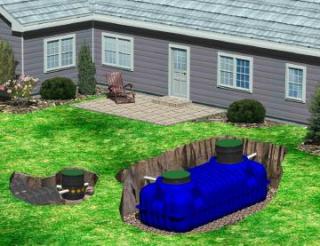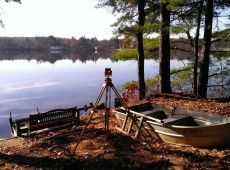CLIMATE CHANGE
A CIVIL ENGINEER’S PERSPECTIVE
JULY 2013
The following is my perspective on “climate change,” its causes and effects on the average homeowner in suburbia.
1. WHAT IS CLIMATE CHANGE?
A. Climate change is directly related to an increase in the earth’s average temperature. The earth’s average temperature has risen approximately 1½º since weather records have been kept, which is a little over 100 years in the United States and since the 1850’s in the United Kingdom. What climate change is is best described by its affects on the earth, including:
i. Increase in ocean levels. The icecaps are melting, of course, they have been melting for years, but we are more keenly aware of it now and some scientists believe they are melting at a faster rate – probably due to the increase in the earth’s average temperature.
ii. Rain events. Many people have noticed the changes in our rain events and other weather patterns. I have heard people say, “We’ve had a 100-year storm each of the past five years.” Well, we really haven’t, but rain events appear to have changed. A 100-year storm in the northeast is a rain storm that drops approximately 6½” to 7” of rain in a 24 hour period. A 100-year storm is a statistical event that has a one (1%) percent chance of happening in any given year. Likewise, a one year storm (2½” of rain in 24 hours) has a one hundred (100%) percent chance of happening in any given year. Based on historical date, kept by the National Weather Service (NWS), which is a division of the National Oceanic and Atmospheric Administration (NOAA), over the past 100+ years, rain falls in a very distinct pattern over a 24 hour period. This rainfall is referred to as a Type III rainfall. In the northeast, we often have summer thunderstorms that drop tremendous amounts of rain in a short period of time, but these are not typical of a rain event in this area. Based on recent studies, many engineers and scientists are suggesting that the 100-year storm event rainfall should be increased to 8.0” in a 24 hour period for stormwater management design purposes. Interestingly, while the individual rain events appear to be different from past experiences, the total annual rainfall, which is approximately 43”, has remained fairly constant. Clearly, we will continue to experience more atypical rain events in the future.
iii. Groundwater elevations will also be impacted. As rainfall events increase in intensity, groundwater elevations will likely increase, at least during the short term following rain events. If annual rainfall totals do not increase dramatically, it is unlikely that average groundwater elevations will increase dramatically. However, higher spikes (during spring and other rainy periods) in the groundwater elevations appear likely and it appears that those spikes could last longer.
iv. The Landscape. I’m sure most people have noticed areas along the sides of roads where the trees have died due to prolonged flooding of an area. While some of this is clearly due to changes in the area, such as new development or topographic changes, or long-term sediment buildup, some is not. It appears the unusual rain events mentioned above result in flooding of some low lying areas for a longer period and the result is that trees and other vegetation die
v. Birds, insects, and animals may also be affected. We have all read about disease carrying mosquitoes becoming more prevalent. As temperatures warm, the mosquitoes move farther north. Polar bears are losing habitat, seals are more prevalent farther north, and the sharks that feed on them are more prevalent farther north than they once were. Some scientists believe coral reefs, which are living organism, are dying due to the increase in ocean temperatures.
2. WHAT CAUSES CLIMATE CHANGE?
A. Natural progression. This is where the arguments occur. We have good weather records for about a century and one-half. Given that the earth is millions of years old, we know very little about its long-term weather history. Other information is gleaned from other records like the Bible, but these records usually note an event, not a trend. We know that ice covered much of the earth at one time and it retreated, leaving a new landscape. Therefore, it seems clear that the change in temperature, in part, is due to the earth itself. Changing and evolving as it has for those millions of years.
B. Greenhouse gases. Man has been “polluting” the earth for centuries. Over the past 200± years, our technology increased the rate of the pollution and we are seeing the effects of that. What part of the increase in the earth’ temperature is due to man? New “clean” fuels, recycling programs, organic fertilizers and pesticides and other actions will at least reduce the rate of increase due to man, but are unlikely to change the fact that the earth is getting warmer and some damage may be irreparable. Some scientists believe that the elimination of hydrochlorofluorocarbons from the atmosphere, by the Montreal Protocol Treaty, may allow the ozone layer to repair itself in a few decades.
3. HOW WILL IT AFFECT HOMEOWNERS?
A. Potable water. Whether you get your drinking water from a well on your property or from a municipal source, your water is at risk. Pollution of the supply will continue to be a major issue. However, there are other potential risks. In this part of the country, we are fortunate that our weather has been relatively consistent. Rainfall is distributed fairly evenly across the months. Sure, it’s often rainier in the spring and July and August can be dry, but overall, we get a even distribution of rain, averaging approximately 3” – 4” on a monthly basis.
i. Reservoirs. With more extreme events, a change in the rain distribution could affect the amount of water in reservoirs. More water in a shorter period could result in some of the water bypassing the reservoir and therefore not being available for future use during dry periods.
ii. Extreme rain events could cause more water to run off into rivers and streams and less infiltrating back into the ground recharging the groundwater supply and well systems.
B. Septic Systems. With higher groundwater comes the potential for septic systems to pollute the groundwater, including wells and nearby rivers, streams and wetlands. Traditional science indicates that a properly operating septic system will treat the sewage before it encounters the groundwater. It does this naturally and without chemicals. However, failed septic systems or those constructed too close to the groundwater can add nitrogen and other contaminates to water bodies and wetlands. The added nitrogen affects the natural order, impacting both flora and fauna.
C. Drainage and flooding. Extreme rain events increase the potential for flooding by adding a large amount of water over a short period and existing drainage systems, both natural and manmade, are incapable of handing the increase, thereby causing flooding. The extreme events also have the potential to increase erosion of unstable ground. The sediment that results enters the rivers, streams, and wetland areas raising surface elevations inthose areas, which results in more flooding of upland areas.
D. Landscape. Changing weather patterns means the potential for dry longer periods, which means water for landscape uses could increase during those dry periods. The need for more irrigation means a higher cost to maintain the landscape and less potable water being available.
4. WHAT CAN YOU DO?
Here is a point for more disagreement. I worked with an engineer once who said “dump the sewage in the ocean; it is so vast that we can never pollute it.” Well everybody knows this is not true. But some people still think that there is nothing that an individual can do to change the environment. Here are some suggestions:
A. Recycle. Sounds easy, but a recent study shows less than 40% of Massachusetts residents recycle. Other states have much higher rates (California at approximately 70%). Studies show that municipalities with recycling programs have much better rates than those without. Encourage your neighbors and community leaders.
B. Don’t forget to recycle grass and leaves. Compost them yourself or bring them to a compost center. Don’t bag the grass clippings, use a mulching mower, and leave them on the lawn.
C. Reduce water consumption. Use low flow toilets, fix leaks, use low maintenance landscape plantings, water lawns less. This is important even if you have your own well.
D. Maintain your septic system in good working order. Have it inspected annually by a professional.
E. Use organic fertilizers and pesticides and use only when necessary.
F. Consider a compost bin.
G. Discharge your downspouts out onto your lawn. This will increase recharge of groundwater. Consider a rain barrel to collect runoff for use around the garden.
H. Consider reducing impervious surfaces; instead use pervious pavers for walks, patios, driveways, etc. Instead of running off into a drainage system, the water gets recharged into the ground.
I. Plant a tree, or two, plants shrubs, once established trees and shrubs don’t need regular watering and they provide shade. Keep manicured lawn areas to a minimum.
J. Fix bare soil so that it does not erode away into a wetland or catch basin.
K. Reduce sand and salt use during the winter. Both wind up in the wetlands. The sand buries wetland plants and raises the elevation of the wetlands and the salt changes the pH of the water, affecting plants and animals.
Not everybody can do all these things, but everybody can do some of them. Mankind probably cannot stop climate change, but we can reduce the rate at which the climate is changing.
 A Guide to A Homeowners Septic System Manual
A Guide to A Homeowners Septic System Manual


